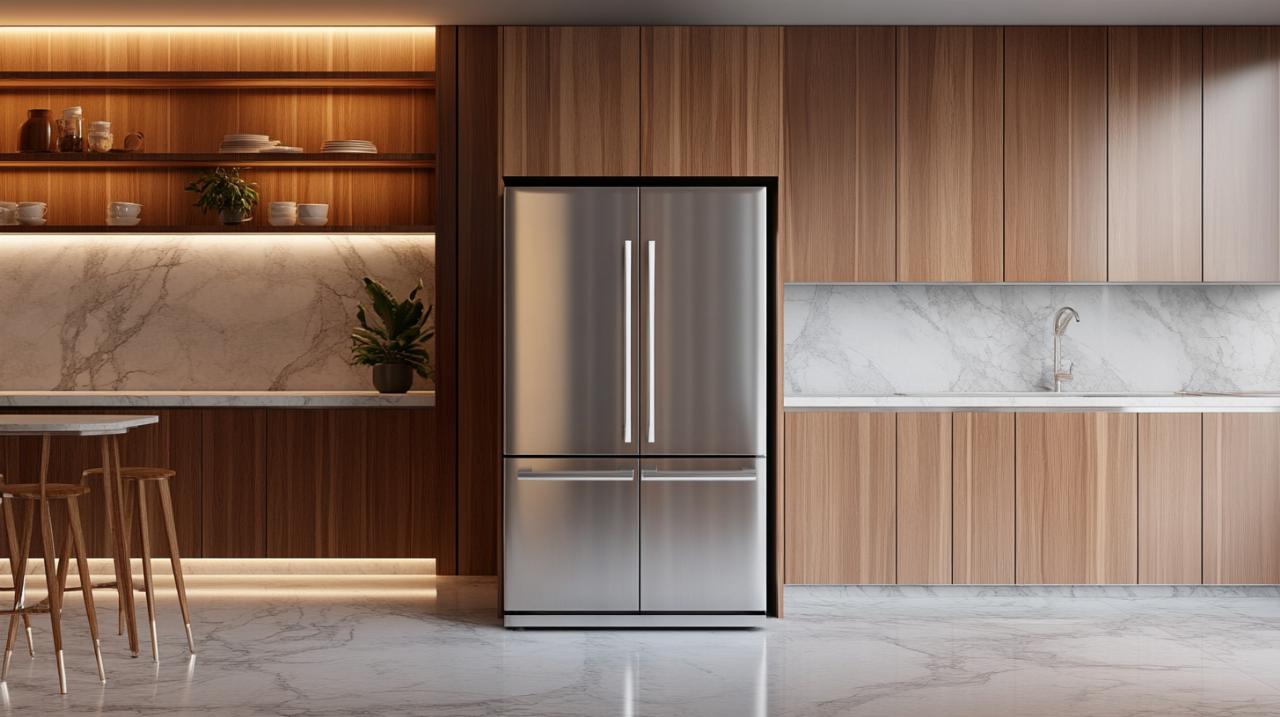Selecting the perfect American fridge freezer for your home requires a thoughtful approach that balances practicality with modern convenience. These imposing appliances have become increasingly popular in British kitchens, offering generous storage and cutting-edge technology. However, their size and range of features demand careful consideration before making a purchase. Understanding what to prioritise will help ensure you invest in an appliance that serves your household efficiently for years to come.
Dimensions and space considerations
Measuring your kitchen space accurately
American fridge freezers are substantially larger than their standard counterparts, typically exceeding ninety centimetres in width and seventy centimetres in depth. This makes precise measurement of your available kitchen space absolutely essential before committing to a purchase. You must account not only for the footprint of the appliance itself but also for the clearance required around it. Many homeowners overlook this crucial step and find themselves unable to accommodate their new purchase comfortably. Taking accurate measurements of the designated space, including height, width, and depth, will prevent disappointment and the inconvenience of returns or exchanges.
Ensuring proper ventilation and door clearance
Beyond the basic dimensions, proper ventilation is critical for the longevity and efficiency of your appliance. Manufacturers recommend leaving at least three centimetres around the fridge freezer to allow adequate airflow, which prevents overheating and ensures optimal performance. Additionally, you must verify that the doors can open fully without obstruction. Some models feature doors that swing wide, requiring significant clearance, whilst others are designed with space-saving hinges for tighter kitchens. If your kitchen layout is compact, consider models with doors that open less widely or those with French door configurations, which require less clearance space when accessing the interior. Failing to account for door swing can result in damaged cabinetry or restricted access to your food storage.
Storage capacity and interior configuration
Assessing your household's food storage needs
Understanding the american fridge features to consider begins with evaluating your household's specific storage requirements. Capacity is typically measured in litres, with American-style models generally offering over four hundred litres, making them ideal for larger families or those who prefer to buy groceries in bulk. Smaller households of one or two people may find such expansive capacity unnecessary and potentially wasteful, as these larger units consume more energy. A family of four to five typically benefits from around six hundred litres of storage, whilst households with more than five members might require seven hundred litres or more. Reflecting honestly on your shopping habits, meal preparation routines, and household size will guide you towards a capacity that meets your needs without excess.
Flexible shelving and compartment options
Modern American fridge freezers offer sophisticated interior configurations that go beyond simple shelving. Look for models with adjustable shelves that allow you to customise the layout according to the size and shape of your groceries. Specialist compartments for meat, dairy, and fresh produce help maintain optimal conditions for different food types, extending freshness and reducing waste. Some advanced models include flexible storage zones that can function as either fridge or freezer space, adapting to seasonal demands or special occasions. These features enhance the practicality of your appliance and ensure that you can organise your food efficiently, making daily use more convenient and helping to prevent forgotten items from spoiling at the back of deep shelves.
Energy efficiency and running costs
Understanding energy ratings and long-term savings
Energy efficiency represents one of the most significant factors affecting the long-term cost of ownership for any large appliance. American fridge freezers with higher energy ratings, such as A+ to A+++, consume considerably less electricity than lower-rated models. An A+ rated appliance uses approximately twenty per cent less energy than an A rated one, whilst A++ rated models can reduce energy consumption by up to forty per cent. Energy-Star certified appliances use at least twenty per cent less energy than standard requirements, and modern fridges can use up to fifty per cent less energy than those manufactured a decade ago. These efficiency improvements translate directly into lower electricity bills, which can amount to substantial savings over the appliance's lifespan. Investing in a more efficient model may have a higher upfront cost but pays dividends through reduced running costs over the years.
Comparing annual energy consumption figures
When evaluating different models, pay close attention to the annual energy consumption figures provided on the energy label. This data, expressed in kilowatt-hours per year, offers a standardised basis for comparison that allows you to calculate approximate running costs based on your electricity tariff. Features such as inverter compressors and advanced insulation materials significantly improve efficiency by maintaining consistent temperatures with less energy expenditure. Additionally, consider the environmental impact of your choice, as lower energy consumption reduces your carbon footprint. Manufacturers increasingly incorporate innovative technologies that enhance performance whilst minimising energy use, making it possible to enjoy the convenience of a large American fridge freezer without excessive environmental or financial cost.
Advanced features and technology
Ice makers, water dispensers, and smart connectivity
Contemporary American fridge freezers come equipped with an array of advanced features that enhance convenience and functionality. Ice and water dispensers provide chilled refreshment at the touch of a button, though it is important to determine whether the model requires a direct plumbing connection or uses a water reservoir that you refill manually. Smart technology integration allows remote control of temperature settings via WiFi connectivity, and some models can send alerts to your smartphone if the door has been left open, preventing energy waste and potential food spoilage. Additional features such as fast freeze functions rapidly bring newly added items to the correct temperature, preserving quality and nutritional value. Holiday mode reduces the fridge's energy consumption when you are away whilst maintaining the freezer, and No Frost technology eliminates the need for manual defrosting by preventing ice build-up.

Weighing up essential features against your budget
Whilst the array of available features can be impressive, it is essential to distinguish between genuinely useful additions and unnecessary extras that inflate the price. Consider which features align with your lifestyle and daily routines. For instance, a water dispenser is convenient for families who consume large quantities of chilled water, but if you rarely use such amenities, the added cost and complexity may not be justified. Similarly, smart connectivity appeals to those who value home automation and remote monitoring, but offers little benefit to households that prefer straightforward operation. Evaluate each feature's practical value to your circumstances, balancing convenience against the additional expense. Remember that more complex features can also mean more components that may require maintenance or repair over time.
Brand reliability and customer reviews
Researching reputable manufacturers
The brand you choose significantly influences the reliability, performance, and longevity of your American fridge freezer. Established manufacturers with strong reputations for quality and customer service are generally safer choices than lesser-known brands. Companies such as Beko, Samsung, Bosch, and Whirlpool have extensive experience in refrigeration technology and maintain robust support networks. Beko, for example, employs over fifty-five thousand people, operates in fifty-seven countries, and maintains forty-five production facilities across thirteen countries, demonstrating substantial industry presence and stability. The company also invests heavily in research and development, with thirty-one centres employing over two thousand three hundred researchers and holding more than three thousand five hundred international patents. Such commitment to innovation and quality assurance suggests a manufacturer dedicated to producing reliable, technologically advanced appliances.
Reading genuine customer feedback and ratings
Beyond manufacturer reputation, genuine customer reviews provide invaluable insights into real-world performance and potential issues. Look for patterns in feedback rather than focusing on isolated complaints or praise. Consistent mentions of specific problems, such as noisy operation, poor temperature control, or frequent breakdowns, should raise red flags. Conversely, repeated positive comments about longevity, efficient cooling, and responsive customer service indicate a reliable product. Independent review platforms and consumer forums often provide more candid assessments than manufacturer websites. Pay attention to comments regarding after-sales support, as the quality of warranty service and availability of replacement parts can significantly affect your ownership experience. A fridge freezer can last between ten and twenty years with proper care, so choosing a model with proven durability and reliable support is a wise investment.
Budget Planning and Value for Money
Setting a realistic budget before shopping
Establishing a clear budget before you begin shopping helps narrow your options and prevents overspending on features you do not need. Prices for American fridge freezers vary widely, typically ranging from around six hundred pounds to over two thousand pounds. Entry-level models offer basic functionality and adequate capacity, whilst premium options include advanced technology, superior build quality, and extensive feature sets. Determine what you can comfortably afford without compromising other household expenses, and remember to factor in potential delivery, installation, and disposal costs for your old appliance. Setting a realistic budget also helps you focus on models that offer the best value within your price range rather than being swayed by aspirational features that stretch your finances unnecessarily.
Identifying the Best Value Options in Your Price Range
Value for money does not necessarily mean choosing the cheapest option available. Instead, it involves finding a model that offers the optimal combination of capacity, efficiency, features, and reliability for your budget. Compare specifications and energy ratings across different brands and models within your price range, considering the long-term savings that higher efficiency ratings provide. Sometimes, spending slightly more upfront for better energy efficiency or proven reliability results in lower overall cost of ownership. Look for sales opportunities, such as Black Friday deals or end-of-line clearances, which can make higher-specification models more affordable. Additionally, investigate finance options that may be available, including interest-free credit arrangements, which can make a quality appliance more accessible whilst spreading the cost over several months.
Design aesthetics and kitchen integration
Choosing a finish that complements your kitchen décor
The visual impact of an American fridge freezer in your kitchen should not be underestimated, as these substantial appliances inevitably become focal points. Selecting a finish that harmonises with your existing décor creates a cohesive, aesthetically pleasing environment. Consider the overall style of your kitchen, including cabinet finishes, worktop materials, and other appliances, when making your choice. A well-integrated fridge freezer enhances the visual appeal of your kitchen and can even increase the perceived value of your home. Conversely, a model that clashes with your décor can appear out of place and detract from the overall design scheme.
Stainless steel, black, white, and contemporary alternatives
Stainless steel remains a perennially popular choice for its professional appearance, durability, and ease of cleaning, though it does show fingerprints and smudges more readily than other finishes. Black finishes offer a sleek, modern look that suits contemporary kitchens and minimises the visibility of marks and smudges. White models provide a classic, clean aesthetic that works particularly well in traditional or country-style kitchens. Increasingly, manufacturers offer alternative finishes such as slate, graphite, or even custom panel-ready options that allow you to match your cabinetry precisely. These contemporary alternatives provide greater flexibility for achieving a seamless, integrated look. Consider the maintenance requirements of each finish, as some require more frequent cleaning to maintain their appearance. Ultimately, your choice should reflect both your personal taste and the practical realities of daily use in a busy kitchen environment.



